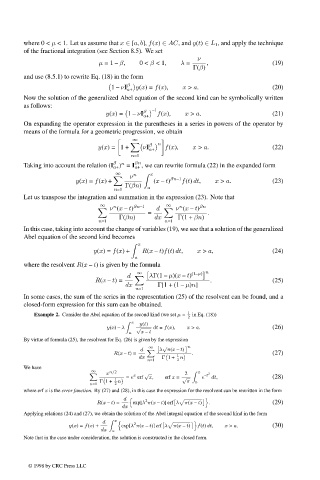Page 486 - Handbook Of Integral Equations
P. 486
where 0 < µ < 1. Let us assume that x ∈ [a, b], f(x) ∈ AC, and y(t) ∈ L 1 , and apply the technique
of the fractional integration (see Section 8.5). We set
ν
µ =1 – β, 0 < β <1, λ = , (19)
Γ(β)
and use (8.5.1) to rewrite Eq. (18) in the form
β
1 – νI y(x)= f(x), x > a. (20)
a+
Now the solution of the generalized Abel equation of the second kind can be symbolically written
as follows:
β –1
y(x)= 1 – νI a+ f(x), x > a. (21)
On expanding the operator expression in the parentheses in a series in powers of the operator by
means of the formula for a geometric progression, we obtain
∞ n
y(x)= 1+ νI β f(x), x > a. (22)
a+
n=1
β n βn
Taking into account the relation (I a+ ) = I a+ , we can rewrite formula (22) in the expanded form
∞ n x
ν βn–1
y(x)= f(x)+ (x – t) f(t) dt, x > a. (23)
Γ(βn) a
n=1
Let us transpose the integration and summation in the expression (23). Note that
∞ n βn–1 ∞ n βn
ν (x – t) d ν (x – t)
= .
Γ(βn) dx Γ(1 + βn)
n=1 n=1
In this case, taking into account the change of variables (19), we see that a solution of the generalized
Abel equation of the second kind becomes
x
y(x)= f(x)+ R(x – t)f(t) dt, x > a, (24)
a
where the resolvent R(x – t) is given by the formula
∞
d λΓ(1 – µ)(x – t) (1–µ) n
R(x – t)= . (25)
dx Γ[1 + (1 – µ)n]
n=1
In some cases, the sum of the series in the representation (25) of the resolvent can be found, and a
closed-form expression for this sum can be obtained.
Example 2. Consider the Abel equation of the second kind (we set µ = 1 in Eq. (18))
2
x y(t)
y(x) – λ √ dt = f(x), x > a. (26)
a x – t
By virtue of formula (25), the resolvent for Eq. (26) is given by the expression
√ n
∞
d λ π(x – t)
R(x – t)= . (27)
dx Γ 1+ 1 n
n=1 2
We have
∞ n/2 x
x x √ 2 –t 2
= e erf x, erf x ≡ √ e dt, (28)
Γ 1+ 1 n π
n=1 2 0
where erf x is the error function. By (27) and (28), in this case the expression for the resolvent can be rewritten in the form
d
2
R(x – t)= exp[λ π(x – t)] erf λ π(x – t) . (29)
dx
Applying relations (24) and (27), we obtain the solution of the Abel integral equation of the second kind in the form
d x
2
y(x)= f(x)+ exp[λ π(x – t)] erf λ π(x – t) f(t) dt, x > a. (30)
dx a
Note that in the case under consideration, the solution is constructed in the closed form.
© 1998 by CRC Press LLC
© 1998 by CRC Press LLC
Page 468

